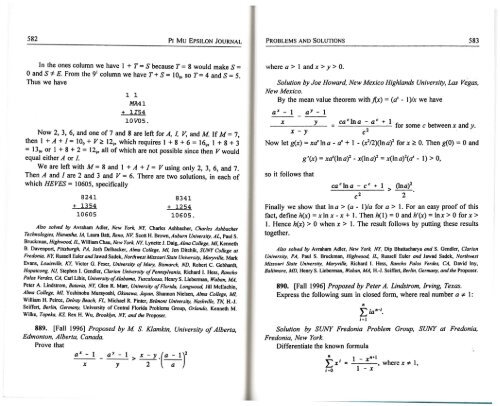Vol. 10 No 7 - Pi Mu Epsilon
Vol. 10 No 7 - Pi Mu Epsilon
Vol. 10 No 7 - Pi Mu Epsilon
Create successful ePaper yourself
Turn your PDF publications into a flip-book with our unique Google optimized e-Paper software.
582 PI MU EPSILON JOURNAL<br />
PROBLEMS AND SOLUTIONS 583<br />
In the ones column we have I + T = S because T = 8 would make S =<br />
0 and S =FE. From the 9' column we have T+ S = I0 9 , soT= 4 and S = 5.<br />
Thus we have<br />
1 1<br />
MA41<br />
+ 1I54<br />
<strong>10</strong>V05.<br />
<strong>No</strong>w 2, 3, 6, and one of 7 and 8 are left for A, I, V, and M. If M = 7,<br />
then I + A + I = I 09 + V :: I29, which requires I + 8 + 6 = I6 9 , I + 8 + 3<br />
= I39, or I + 8 + 2 = I29, all of which are not possible since then V would<br />
equal either A or I.<br />
We are left with M = 8 and I +A +I= V using only 2, 3, 6, and 7.<br />
Then A and I are 2 and 3 and V = 6. There are two solutions, in each of<br />
which HEVES = I 0605, specifically<br />
8241<br />
+ 1354<br />
<strong>10</strong>605<br />
8341<br />
+ 1254<br />
<strong>10</strong>605.<br />
Also solved by Avraham Adler, New York, NY. Charles Ashbacher, Charles Ashbacher<br />
Technologies, Hiawatha, /A, Laura Batt, Reno, NV. Scott H. Brown, Auburn University, AL, Paul S.<br />
Bruckman, Highwood, IL, William Chau, New York, NY. Lynette J. Daig, Alma College, Ml, Kenneth<br />
B. Davenport, <strong>Pi</strong>ttsburgh, PA, Josh Delbacker, Alma College, Ml, Jen Ditchik, SUNY College at<br />
Fredonia, NY. Russell Euler and Jawad Sadek, <strong>No</strong>rthwest Missouri State University, Maryville, Mark<br />
Evans, Louisville, KY, Victor G. Feser, University of Mary, Bismarck, ND, Robert C. Gebhardt,<br />
Hopatcong, NJ, Stephen I. Gendler, Clarion University of Pennsylvania, Richard I. Hess, Rancho<br />
Palos Verdes, CA, Carl Lib is, University of Alabama, Tuscaloosa, HenryS. Lieberman, Waban, MA,<br />
Peter A. Lindstrom, Batavia, NY. Glen R. Marr, University of Florida, Longwood, Jill McEachin,<br />
Alma College, Ml, Yoshinobu <strong>Mu</strong>rayoshi, Okinawa, Japan, Shannon Nielsen, Alma College, MJ,<br />
William H. Peirce, Delray Beach, FL, Michael R. <strong>Pi</strong>nter; Belmont University, Nashville, TN, H.-J.<br />
Seiffert, Berlin, Germany, University of Central Florida Problems Group, Orlando, Kenneth M.<br />
Wilke, Topeka, KS, Rex H. Wu, Brooklyn, NY. and the Proposer.<br />
889. [Fall I996] Proposed by M S. Klamkin, University of Alberta,<br />
Edmonton, Alberta, Canada.<br />
Prove that<br />
where a > I and x > y > 0.<br />
Solution by Joe Howard, New Mexico Highlands University, Las Vegas,<br />
New Mexico.<br />
By the mean value theorem withj{x) = (d- I)/x we have<br />
a 1 - 1<br />
X y ca c In a - a c + 1<br />
------- for some c between x andy.<br />
x-y<br />
c2<br />
<strong>No</strong>w let g(x) = xd In a - d + I - (x 2 /2)(ln a) 2 for x :: 0. Then g(O) = 0 and<br />
so it follows that<br />
g'(x) = xd(lna) 2 - x(lna) 2 = x(lna) 2 (d- I)> 0,<br />
ca c In a - c c + 1 (lnal<br />
-------- > ----.<br />
c2 2<br />
Finally we show that In a > (a - I)/a for a> I. For an easy proof of this<br />
fact, define h(x) = x In x- x + I. Then h(l) = 0 and h'(x) = lnx > 0 for x ><br />
I. Hence h(x) > 0 when x > I. The result follows by putting these results<br />
together.<br />
Also solved by Avraham Adler, New York, NY. Dip Bhattacharya and S. Gendler, Clarion<br />
University, PA, Paul S. Bruckman, Highwood, IL, Russell Euler and Jawad Sadek, <strong>No</strong>rthwest<br />
Missouri State University, Maryville, Richard I. Hess, Rancho Palos Verdes, CA, David Iny,<br />
Baltimore, MD, HenryS. Lieberman, Waban, MA, H.-J. Seiffert, Berlin, Germany, and the Proposer.<br />
890. [Fall I996] Proposed by Peter A. Lindstrom, Irving, Texas.<br />
Express the following sum in closed form, where real number a ::P I:<br />
II<br />
~ • 11-i<br />
LJ za .<br />
i=l<br />
Solution by SUNY Fredonia Problem Group, SUNY at Fredonia,<br />
Fredonia, New York.<br />
Differentiate the known formula<br />
1 - x 11 • 1<br />
----, where x :~:. I,<br />
1 -X<br />
·..
















